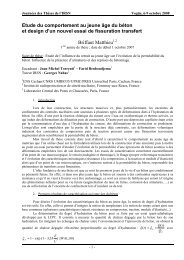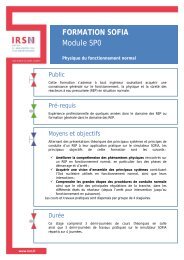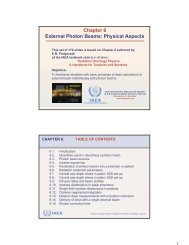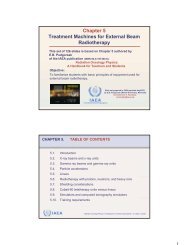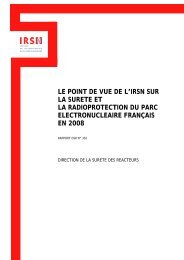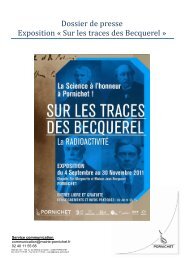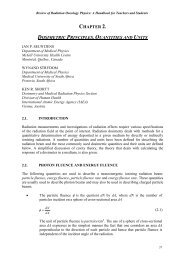Review of Radiation Therapy Physics: A syllabus for teachers ... - IRSN
Review of Radiation Therapy Physics: A syllabus for teachers ... - IRSN
Review of Radiation Therapy Physics: A syllabus for teachers ... - IRSN
You also want an ePaper? Increase the reach of your titles
YUMPU automatically turns print PDFs into web optimized ePapers that Google loves.
Chapter 11. Computerized Treatment Planning Systems <strong>for</strong> External Beam radiotherapy- Semi-empirical dose calculation methods model the dose to a point byconsidering the contribution from the primary and scattered radiationindependently. Based originally on the Clarkson scatter integrationtechnique, these models have been refined by combining the <strong>for</strong>malism <strong>of</strong>basic physics with data derived from measurement. Correction factors toaccount <strong>for</strong> penumbra, block transmission and flattening filters haveimproved on these models.- These methods have been further refined by applying differential scatter-airratio techniques to allow <strong>for</strong> variations in the intensity <strong>of</strong> scatter radiationthroughout the field due to the presence <strong>of</strong> wedges or non-uni<strong>for</strong>m surfacecontours.- Three-dimensional integration methods represent the transport <strong>of</strong> electronsand photons away from the primary site <strong>of</strong> interaction so as to have anaccurate description <strong>of</strong> the deposition <strong>of</strong> absorbed energy while consideringthe geometry and composition <strong>of</strong> the entire volume being irradiated. MonteCarlo techniques <strong>for</strong> computing dose spread arrays or kernels used inconvolution-superposition methods are described by numerous authorsincluding Mackie and the review chapters in Khan and Potish, and Van Dykprovide a detailed summary <strong>of</strong> treatment planning algorithms in general.11.3.2. Beam modifiersTreatment planning s<strong>of</strong>tware <strong>for</strong> photon beams as well as electron beams must be capable <strong>of</strong>handling many diverse beam modifying devices found on specific linac models. Some <strong>of</strong>these devices are generic to all linacs, whereas others are specific to certain manufacturers.Some <strong>of</strong> these devices and specific considerations <strong>for</strong> incorporation into the TP system arelisted below, separated into two main groups: photon beam modifiers (consisting <strong>of</strong> jaws,blocks, compensators, MLCs, wedges and) and electron beam modifiers (consisting <strong>of</strong> cones,blocks, bolus, etc.).Photon beam modifiers• Jaws: Field size is defined with motorized collimating devices (jaws). Jaws canmove independently or in pairs, and are usually located as an upper and lower set.Jaws may over-travel the central axis <strong>of</strong> the field by varying amounts. The travelmotion (transverse or arced) will determine the junction produced by two abuttingfields. The TP system will account <strong>for</strong> penumbra produced by location <strong>of</strong> thesejaws, and differences in radial and transverse open beam symmetry due to jawdesign may also be considered.• Blocks: Field shielding is accounted <strong>for</strong> in the TP system by considering theeffective attenuation <strong>of</strong> the block to reduce the total dose under the shieldedregion. The dose through a partially shielded calculation volume, or voxel, iscalculated by a partial sum <strong>of</strong> the attenuation proportional to the region <strong>of</strong> thevoxel shielded. The geometry <strong>of</strong> straight edge and tapered blocks can beconsidered separately so as to more accurately model the penumbra through theregion <strong>of</strong> the block edge. TP systems are able to generate files <strong>for</strong> blocked fieldsthat can be exported to commercial block-cutting machines.322



